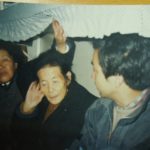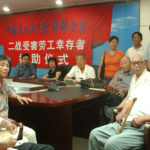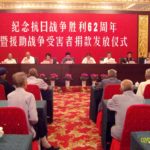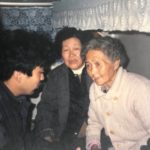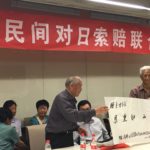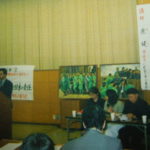Date of letter:1992-12
Address of author:Yangqu County, Taiyuan City, Shanxi Province
Date of event:1937-1941
Location of event:Yangqu County, Taiyuan City, Shanxi Province
Name of author:Wu Jiarong
Name(s) of victim(s):People in Yangqu County
Type of atrocity:Murders, Other Massacres(MU, OM)
Other details:On October 28, 1937, about 110 Japanese soldiers came to our village, and they killed everyone they met. In November 1939 Xu Chengquan was captured and killed; in 1941 Wu Shijin was killed. Our village suffered from the killing of the Japanese Army who killed many of our villagers. Note: The envelope is missing
A Personal Record of the Japanese Army Massacring the People of Wanli Village
On lunar October 24, 1937 (calendar November 26, 1937), the second day after the Japanese Army reached Hanhu Village in the east of Lingjing, Yangqu from Shouyang, they sent a small group of Japanese soldiers to patrol eastward along the road from Hanhu. When they reached the beach in the south of Wanli Village, they came across a troop of the No. 358 brigade of the Eighth Route Army. The two sides fought in the woods by the beach. In the end, some Japanese soldiers were killed by the Chinese troop, while a Chinese platoon leader and soldier were killed by the Japanese troop. Moreover, Han Kuanying from my village and a 5-year-old little girl named Wu Erlin who went to the village entrance to watch what’s happening were also killed by the Japanese troop. The two sides left after the battle. The villagers thought the trouble was over and none of us would’ve known that in 3 days, the Japanese army carried out a massacre in my village.
On lunar October 28, 1937 (calendar November 30, 1937), soon after the sun rose, a heavy wind blew, lifting up loess and clouding the air. Later on the morning, about over 10 Japanese soldiers were led to Wali Village by a Chinese interpreter. First of all, they took away 3 people, all tied-up, from Wu Xueshun’s family and shot them dead on a hill in the south of the village. After that, they would barge in any door they saw and kill any people they found. The victims were bayoneted to death at a gate, or on a street, or in their yard or house. The Japanese soldiers didn’t left for Hanhu Village until about 3 or 4 p.m. after killing for more than half a day.
We were then children of over 10. We hid away after the Japanese soldiers entered the village and couldn’t dare to breathe when hearing their shouts and the cries and screams of the adults being bayoneted. After the Japanese left, we ran out and saw dead people everywhere on the street, on the hill in the south of the village and in the victim’s yard. In some houses, the doors and yards were splashed with blood. After a search, we found that 33 people from Dongwan and Xiwan were killed by the Japanese soldiers, including Wu Dahuan, Wu Chouer, Wu Erguang, Wu Erdan, Wu Yincheng, Wu Genke, Wu Laicheng, Wu Lingui, Xu Shichang, Wu Shouqian, Wu Sandong, Wu Shuangxi, Wu Shiming, Wu Huanzhong, Wu Xueheng, Wu Hongyou, Wu Laibao, Wu Longshan, Wu Yucheng, Wu Yongbing, Wu Yonghou, Wu Yueneng, Wu Yufu, Wu Yugou, Wu Shiming, Wen Sanbao and Wen Wancai. Moreover, 8 more people were killed in Hougou, 4 people including Wu Erlin, Wu Dalai, Wu Suozi and Zuo Kuanying were shot on lunar October 25, 1937 (calendar November 27, 1937), Xu Chengquan was killed after being taken to the Japanese army’s base in Dafangshan in November 1939 and Wu Shizhong was shot dead by the Japanese army on its way from Dongguoqiu back to its base in Hanhu in March 1941. So, a total of 47 people from my village were killed by the Japanese, where 45 people were killed in 4 days alone between lunar October 25 and 28, 1937 in Wanli Village (including Dongwan, Xiwan and Hougou). After the massacre, 11 families including Wu Hongyou, Wu Yonghou and Wu Shoulian lost all of their children and almost every family lost a family member. The people sadly helped each other bury the bodies of their relatives and fearing the Japanese might come for another massacre, all survivors fled to other villages for shelter and didn’t dare to return for over a month.
At first, we didn’t know why the Japanese soldiers carried out a massacre in Wanli Village, but later we knew that their army was from Shouyang and that on lunar October 25, (calendar November 27) 1937, when they were patrolling eastward from Donghanhu, they came across the No. 358 brigade of the Eighth Route Army led by Commander Ruan by the beach in the south of Wanli Village and had a battle with them, in which a group of Japanese soldiers were killed. So, to avenge their defeat, over 100 Japanese soldiers secretly surrounded Wanli Village on that windy, cloudy day under the guide of the Chinese interpreter Da Sen in an attempt to wipe the troops of Commander Ruan. After surrounding the village, they began to search for the Eighth Route Army door by door, but in vain. So they vented their anger on innocent people in the village. They suspected that the young, strong villagers were soldiers of the Eighth Route Army in disguise, so they carried out a massacre on the unarmed people. At first, they took away 4 innocent farmers and bayoneted them to death either on the hill in the south of the village or on the street. Then, they barged door by door to bayonet or shot any young man they saw. In the end, 1 or 2 corpses could be seen at the door or in the yard of many families. In just one day, 45 people were killed by the Japanese army in a small village consisting of 3 residential areas (Xiwan, Dongwan and Hougou), with over 40 households and 250 people. And among the 45 victims, there were 2 old men of over 60 and one 5-year-old little girl. All of the rest 42 victims were young, strong men aged between 20-40. The people of Wanli Village will always remember the heinous massacre that the Japanese invaders implemented in the village.
Wanli, Lingjing, Yangqu, Shanxi
Wu Yaolin, Wu Jiarong
December 20, 1992




